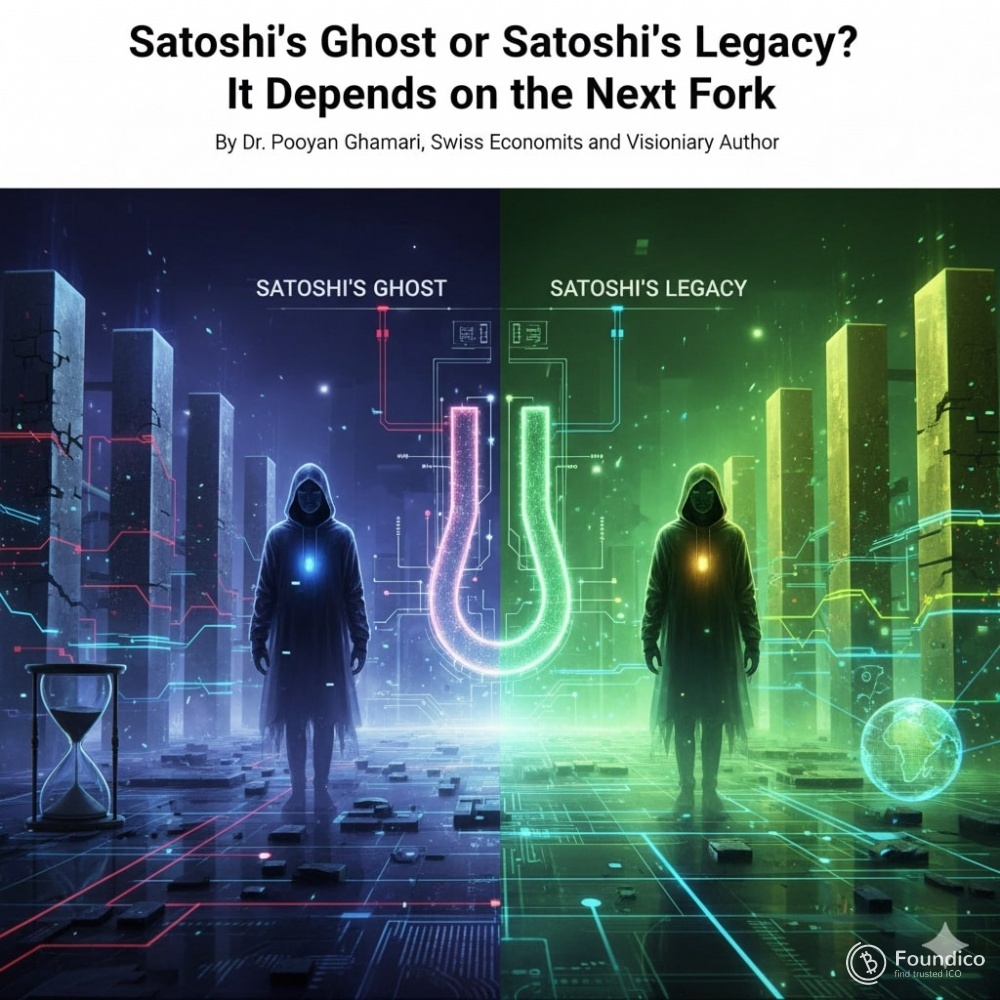Satoshi’s Ghost or Satoshi’s Legacy? It Depends on the Next Fork

By Dr. Pooyan Ghamari, Swiss Economist and Visionary Author
The mystique of Satoshi Nakamoto, Bitcoin’s pseudonymous creator, looms large over the entire cryptocurrency landscape. Unseen, unheard, yet profoundly influential, Satoshi is either a guiding spirit or a haunting specter, depending on one’s perspective and, more critically, on the outcomes of the constant evolution within blockchain protocols. The question of whether Satoshi’s vision will endure as a legacy or dissipate into a mere ghost of an idea often hinges on a single, pivotal event: the next fork.
The Original Vision: Decentralization and Peer-to-Peer
Satoshi’s whitepaper, "Bitcoin: A Peer-to-Peer Electronic Cash System," laid out a radical proposal for digital money free from central banks and intermediaries. The core tenets were decentralization, censorship resistance, and an open, auditable ledger. This was a direct challenge to the established financial order, aiming to empower individuals with direct control over their assets. For many early adopters and purists, this represented Satoshi’s unwavering legacy—a blueprint for true financial autonomy.
However, the very success of Bitcoin has attracted diverse interests, leading to internal debates about its scaling, purpose, and fundamental design. These disagreements often culminate in "forks."
What is a Fork?
In blockchain, a "fork" refers to a split in the blockchain’s history or a change in its rules.
-
Soft Fork: A backward-compatible update where new rules are stricter than old ones. Old nodes still recognize new blocks as valid, though they may not understand all the new features.
-
Hard Fork: A non-backward-compatible update where new rules conflict with old ones. Old nodes will reject new blocks, leading to a permanent split in the blockchain if not all participants upgrade. This is where the profound implications for Satoshi’s vision truly lie.
The Stakes of a Hard Fork: Legacy vs. Ghost
Every significant hard fork presents a crossroads for Satoshi’s original intent.
The Legacy Path: Reinforcing Core Principles
When a hard fork is executed to enhance censorship resistance, improve security without compromising decentralization, or genuinely scale the network to facilitate broader peer-to-peer transactions, it can be argued as upholding Satoshi’s legacy. These forks aim to make the system more robust, accessible, and aligned with the vision of an unburdened electronic cash system. They seek to adapt the technology to new challenges while staying true to the philosophical underpinnings. The intention here is often to fortify the original promise, ensuring the network remains truly decentralized and peer-to-peer, even as it grows.
The Ghost Path: Drifting from the Original Design
Conversely, a hard fork can lead to outcomes that some argue betray Satoshi’s principles, turning the original vision into little more than a ghost of its former self. This might occur if a fork:
-
Centralizes Power: If changes inadvertently or intentionally lead to greater control by a few large entities (e.g., massive mining pools, large corporations, or a small group of core developers), it contradicts the ethos of decentralization.
-
Compromises Censorship Resistance: Introducing features that make transactions easier to track, block, or reverse by external authorities could undermine a core tenet of Bitcoin.
-
Shifts Purpose: If the network is steered away from its function as "electronic cash" towards becoming primarily a settlement layer for other applications, or a store of value exclusively, it might deviate from the original, broader utility envisioned.
The debate around past hard forks, such as the Bitcoin Cash split, vividly illustrates this tension. One side claimed to be preserving the "cash" aspect, while the other prioritized its role as "digital gold" with a different scaling approach. Both claimed fidelity to Satoshi, yet their actions led to distinct paths.
The Ongoing Battle for Narrative and Control
The absence of Satoshi means there is no ultimate arbiter of the "true" vision. This void creates a battleground for competing narratives, each claiming to represent the authentic spirit of the creator. Core developers, influential miners, large corporations, and passionate communities all vie for control over the direction of these protocols.
Ultimately, whether Satoshi’s creation lives on as a vibrant legacy or merely a historical artifact—a ghost in the machine—depends on the collective decisions made with each subsequent fork. These technical decisions are, in essence, philosophical statements about the future of money, decentralization, and digital freedom. The next fork, whatever its nature, will invariably push us further down one of these two paths.

 Maxi Doge - $MAXI is the meme-powered token of Maxi Doge—a body-building, 1000x-leverage-trading Doge who represents ultimate strength, hustle, and the grind of the bull market. He never skips leg day, a 1000x trade, and he definitely never touches grass.
Maxi Doge - $MAXI is the meme-powered token of Maxi Doge—a body-building, 1000x-leverage-trading Doge who represents ultimate strength, hustle, and the grind of the bull market. He never skips leg day, a 1000x trade, and he definitely never touches grass.